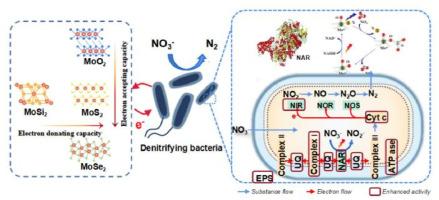Role of molybdenum compounds in enhancing denitrification: Structure-activity relationship and the regulatory mechanisms
IF 8.1
2区 环境科学与生态学
Q1 ENVIRONMENTAL SCIENCES
引用次数: 0
Abstract
The effect and regulatory mechanisms of molybdenum compounds (MoO2, MoS2, MoSe2 and MoSi2) on denitrification were investigated by structure-activity relationships, electrochemical characteristics, microbial metabolism analysis and bacterial community distribution. All the assessed molybdenum compounds exhibited the enhancement effect on denitrification, in the order of MoS2 > MoSi2 > MoSe2 > MoO2, with MoS2 increasing 7.08-fold in 12 h. Analysis of structure-activity relationships suggested that the molybdenum compounds with lower negative redox potential and higher redox reversibility were favorable for promoting denitrification. According to the morphology observation, the interactions between Mo compounds and denitrifying bacteria may be beneficial to extracellular electron transfer. Molybdenum compounds with electron transfer capability facilitated an increase in electron capacitance from 835.1 to 1011.3 μF, promoting the electron exchange rate during denitrification. In the denitrification electron transport chain, the molybdenum compounds upregulated nicotinamide adenine dinucleotide and denitrifying enzyme activity, as well as facilitated the abundance of quinone pools, ATP translocation, and cytochrome c related proteins. Moreover, Mo compounds enriched functional bacteria such as electroactive bacteria and denitrifying functional bacteria. Notably, Mo ions in molybdenum compounds may provide active sites for nitrate reductase, optimizing the electron distribution of the denitrification process and thus improved the partial denitrification efficiency. This work aimed to further understand the regulatory mechanisms of molybdenum on denitrification electron transfer in the compound state and to anticipate the catalytic role of Mo compounds for sustainable water treatment.

钼化合物在提高反硝化作用中的作用:结构-活性关系和调节机制。
通过结构-活性关系、电化学特征、微生物代谢分析和细菌群落分布,研究了钼化合物(MoO2、MoS2、MoSe2和MoSi2)对反硝化的影响和调控机制。结构-活性关系分析表明,负氧化还原电位较低、氧化还原可逆性较高的钼化合物有利于促进反硝化。根据形态观察,钼化合物与反硝化细菌之间的相互作用可能有利于细胞外电子传递。具有电子传递能力的钼化合物可促进电子电容从 835.1 μF 增加到 1011.3 μF,从而提高反硝化过程中的电子交换速率。在反硝化电子传递链中,钼化合物提高了烟酰胺腺嘌呤二核苷酸和反硝化酶的活性,并促进了醌池、ATP转运和细胞色素c相关蛋白的丰度。此外,钼化合物还富集了功能细菌,如电活性细菌和反硝化功能细菌。值得注意的是,钼化合物中的钼离子可为硝酸还原酶提供活性位点,优化反硝化过程中的电子分布,从而提高部分反硝化效率。这项工作旨在进一步了解钼在化合物状态下对反硝化电子传递的调控机制,并预测钼化合物在可持续水处理中的催化作用。
本文章由计算机程序翻译,如有差异,请以英文原文为准。
求助全文
约1分钟内获得全文
求助全文
来源期刊

Chemosphere
环境科学-环境科学
CiteScore
15.80
自引率
8.00%
发文量
4975
审稿时长
3.4 months
期刊介绍:
Chemosphere, being an international multidisciplinary journal, is dedicated to publishing original communications and review articles on chemicals in the environment. The scope covers a wide range of topics, including the identification, quantification, behavior, fate, toxicology, treatment, and remediation of chemicals in the bio-, hydro-, litho-, and atmosphere, ensuring the broad dissemination of research in this field.
 求助内容:
求助内容: 应助结果提醒方式:
应助结果提醒方式:


